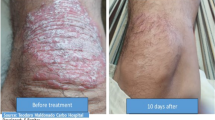Abstract
In a double-blind, randomized, paired trial lasting 14 days in 72 patients with moderately severe atopic eczema, hamamelis distillate cream (5.35 g hamamelis distillate with 0.64 mg ketone/100 g) was compared with the corresponding drug-free vehicle and 0.5% hydrocortisone cream, and reductions of the basic criteria of severe atopic eczema (Δ values of the sum scores), i.e. itching, erythema and scaling, were evaluated. Thirty-six patients in each group were treated, which allowed the detection of a 10% difference between verum and control (confirmatory study). Effects were compard using Wilcoxon's test. The mean sum scores of the basic criteria of the test areas were 5.3–5.5. All treatment regimens significantly reduced itching, erythema and scaling after 1 week. Hydrocortisone proved superior to hamamelis distillate. The basic criteria scores decreased by 2.7 and 1.6, respectively. The Δ values of the minor criteria and the global rating of efficacy were also used to indicate the difference between these preparations. Hamamelis distillate cream, however, did not differ from the vehicle. Mean Δ values of basic criteria were 1.8 and 2.0, respectively. All preparations were well tolerated. Unwanted cutaneous reactions occurred in six patients, although due to their inflammatory nature and their confinement to vehicle-treated patients, they may not represent true adverse effects but rather a lack of efficacy. The results prove the superiority of low-dose hydrocortisone cream over hamamelis distillate cream, and the therapeutic outcome following this preparation was no better than following the base preparation. The mild, yet unmistakable anti-inflammatory effect of hamamelis cream in experimental models of inflammatory skin disease was thus not reflected by an efficacy in patients with atopic eczema greater than that obtained from the base preparation.
Similar content being viewed by others
References
Robertson DB, Maibach HI (1989) Topical glucocorticoids. In: Schleimer RP, Claman HN, Oronsky A (eds) Antiinflammatory steroid action. Basic and clinical aspects. Academic Press, San Diego, pp 495–524
Bateman DN (1989) Clinical pharmacology of topical steroids. In: Greaves MW, Shuster S (eds) Pharmacology of the skin II. Springer, Berlin, Heidelberg New York, pp 239–249
Schäfer-Korting M (1993) Topical glucocorticoids: what has been achieved; what is still to be done? In: Korting HC, Maibach HI (eds) Topical glucocorticoids with increased benefit-risk ratio Karger, Basel, pp 192–201
Schäfer-Korting M, Korting HC, Kerscher MJ, Lenhard S (1993) Prednicarbate activity and benefit/risk ratio in relation to other topical glucocorticoids. Clin Pharmacol Ther 54: 448–456
Anonymous (1994) Pharmaceuticals from plants: great potential, few funds. Lancet 343:1513–1515
Hörmann HP, Korting HC (1994) Evidence for the efficacy and safety of topical herbal drugs in dermatology: part I: anti-inflammatory agents. Phytomed 1:161–171
Korting HC, Schäfer-Korting M, Hart H, Laux P, Schmid M (1993) Anti-inflammatory activity of hamamelis distillate applied topically to the skin. Influence of vehicle and dose. Eur J Clin Pharmacol 44:315–318
Sorkin B (1980) Hametum Salbe, eine kortikoidfreie antiinflammatorische Salbe. Physik Med Rehab 21:53–57
Schweiker RS (1982) Skin protectant drug products for over the counter human use; establishment of a monograph; and the reopening of administrative record. Fed Reg (USA) 47:39436–39451
Della Loggia R (1985) Lokale antiphlogistische Wirkung der Kamillen-Flavone. Dtsch Apoth Ztg 125 [Suppl 1]:9–11
Pfister R (1981) Zur Problematik der Behandlung and Nachbehandlung chronischer Dermatosen. Eine klinische Studie über Hametum Salbe. Fortschr Med 99:1264–1268
Aertgeerts P, Albring M, Klaschka F, Nasemann T, Patzelt-Wenczler R, Rauhut K, Weigl B (1985) Vergleichende Prüfung von KamillosanR Creme gegenüber steroidalen (0,25% Hydrocortison, 0,75% Fluocortinbutylester) und nichtsteroidalen (5% Bufexamac) Externa in der Erhaltungstherapie von Ekzemerkrankungen. Z Hautkrankh 60:270–277
Nissen HP, Biltz H, Kreysel HW (1988) Profilometrie, eine Methode zur Beurteilung der therapeutischen Wirksamkeit von Kamillosan Salbe. Z Hautkrankh 63:184–190
Albring M, Albrecht H, Alcorn G, Lücker PW (1983) The measuring of the antiinflammatory effect of a compound on the skin of volunteers. Methods Find Exp Clin Pharmacol 5:575–577
Laux P, Oschmann R (1993) Die Zaubernuss — Hamamelis virginiana L. Phytother 14:155–166
Swoboda M, Meurer J (1991) Therapie von Neurodermitis mit Hamamelis-virginiana-Destillat in Salbenform. Phytother 12:114–117
Hanifin JM, Rajka G (1980) Diagnostic features of atopic dermatitis. Acta Derm Venereol (Stockholm) 92 [Suppl]:44–47
Borgden RN, Pinder RM, Sawyer PR, Speight TM, Avery GS (1975) Bufexamac: a review of its pharmacological properties and therapeutic efficacy in inflammatory dermatoses. Drugs 10:351–356
Greaves MW, Shuster S (1989) Non-steroidal antiinflammatory agents and the skin. In: Greaves MW, Shuster S (eds) Pharmacology of the skin II. Springer, Berlin Heidelberg New York, pp 301–305
Schäfer-Korting M, Korting HC (1992) Ekzeme, Ekzemtherapie heute. Dtsch Apoth Ztg 132:59–69
Elmets CA (1992) Cutaneous photocarcinogenesis. In: Mukhtar H (ed) Pharmacology of the skin CRC, Boca Raton pp 389–416
Comaish JS (1987) The effect of tar and ultraviolet on the skin. Invest Dermatol 88:61s-64s
Morse PF, Horrobin DF, Manku MS, Stewart JCM, Allen R, Littlewood S, Wright S, Burton J, Gould DJ, Holt PJ, Jansen CT, Mattila L, Meigel W, Dettke T, Wexler D, Guenther L, Bordoni A, Patrizi A (1989) Meta-analysis of placebocontrolled studies of the efficacy of Epogam in the treatment of atopic eczema. Relationship between plasma essential fatty acid changes and clinical response. Br J Dermatol 121:75–90
Garbe E, Rohmel J, Gundert-Remy U (1993) Clinical and statistical issues in therapeutic equivalence trials. Eur J Clin Pharmacol 45:1–7
Täuber U (1994) Dermatocorticosteroids: structure, activity, pharmacokinetics. Eur J Dermatol 4:419–429
Korting HC, Kerscher MJ, Schäfer-Korting M (1992) Topical glucocorticoids with improved benefit-risk ratio — do they exist? J Am Acad Dermatol 27:87–92
Kerscher MJ, Korting HC (1992) Topical glucocorticoids of the non-fluorinated double-ester type. Lack of atrophogenicity in normal skin as assessed by high-frequency ultra-sound. Acta Derm Venereol (Stockholm) 72:214–216
Author information
Authors and Affiliations
Rights and permissions
About this article
Cite this article
Korting, H.C., Schäfer-Korting, M., Klövekon, W. et al. Comparative efficacy of hamamelis distillate and hydrocortisone cream in atopic eczema. Eur J Clin Pharmacol 48, 461–465 (1995). https://doi.org/10.1007/BF00194335
Received:
Accepted:
Issue Date:
DOI: https://doi.org/10.1007/BF00194335




